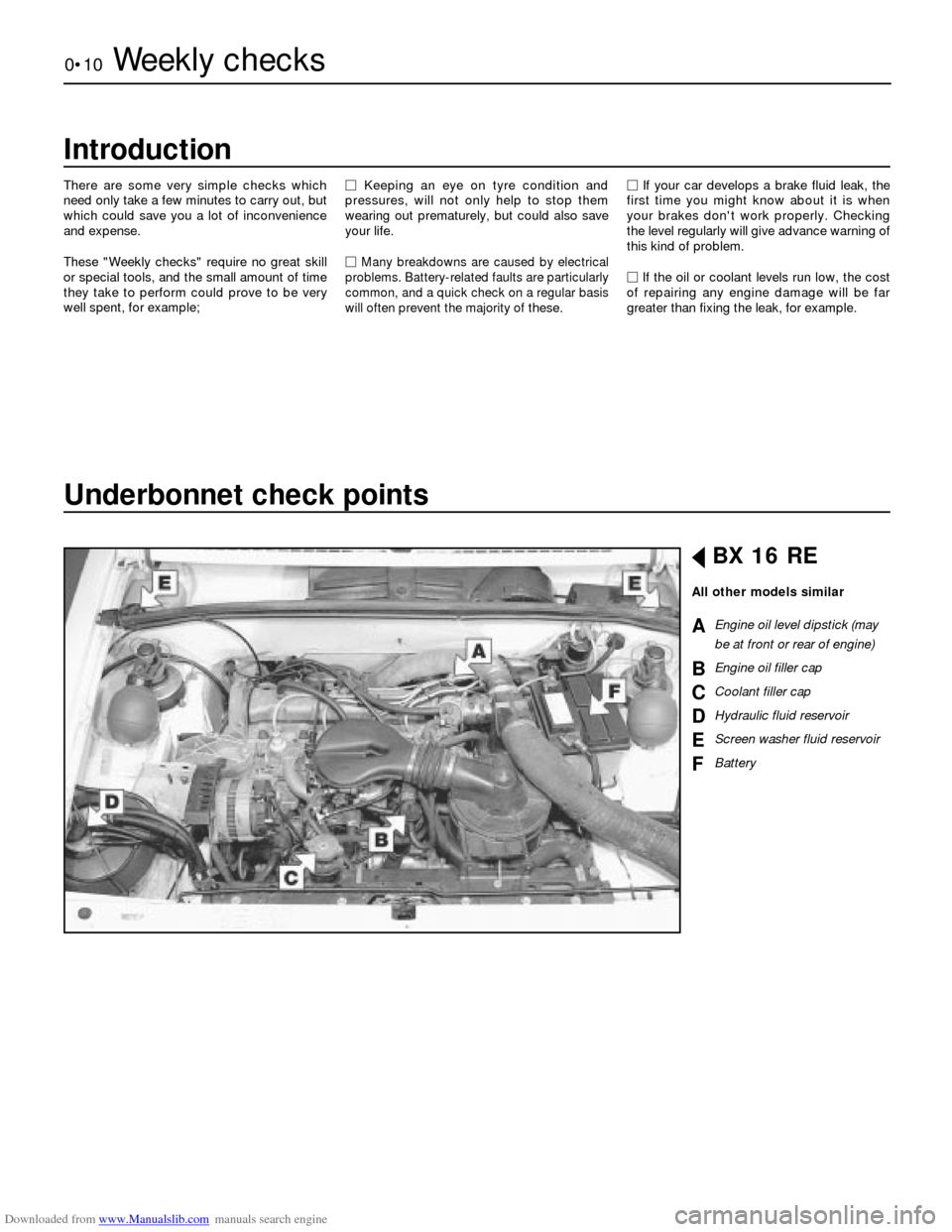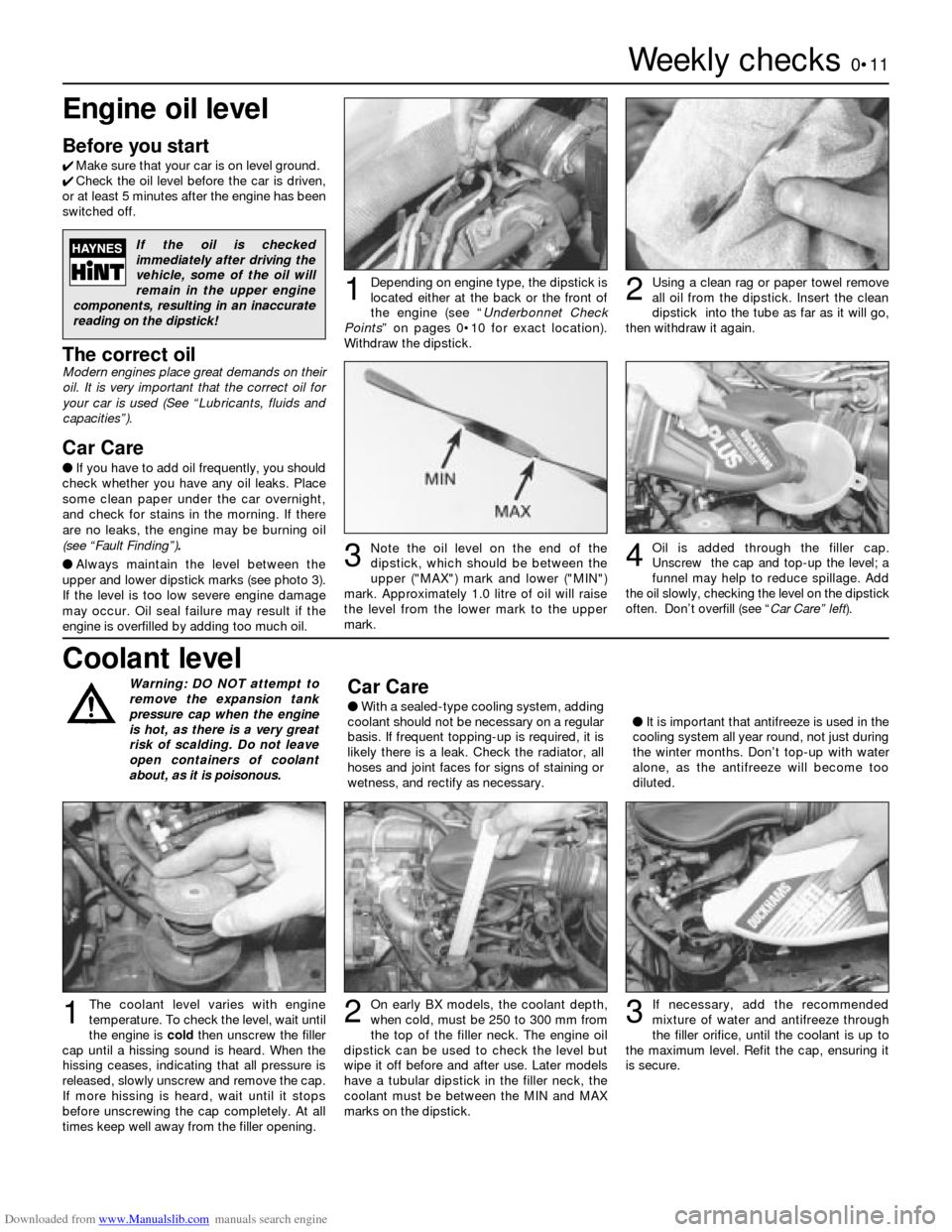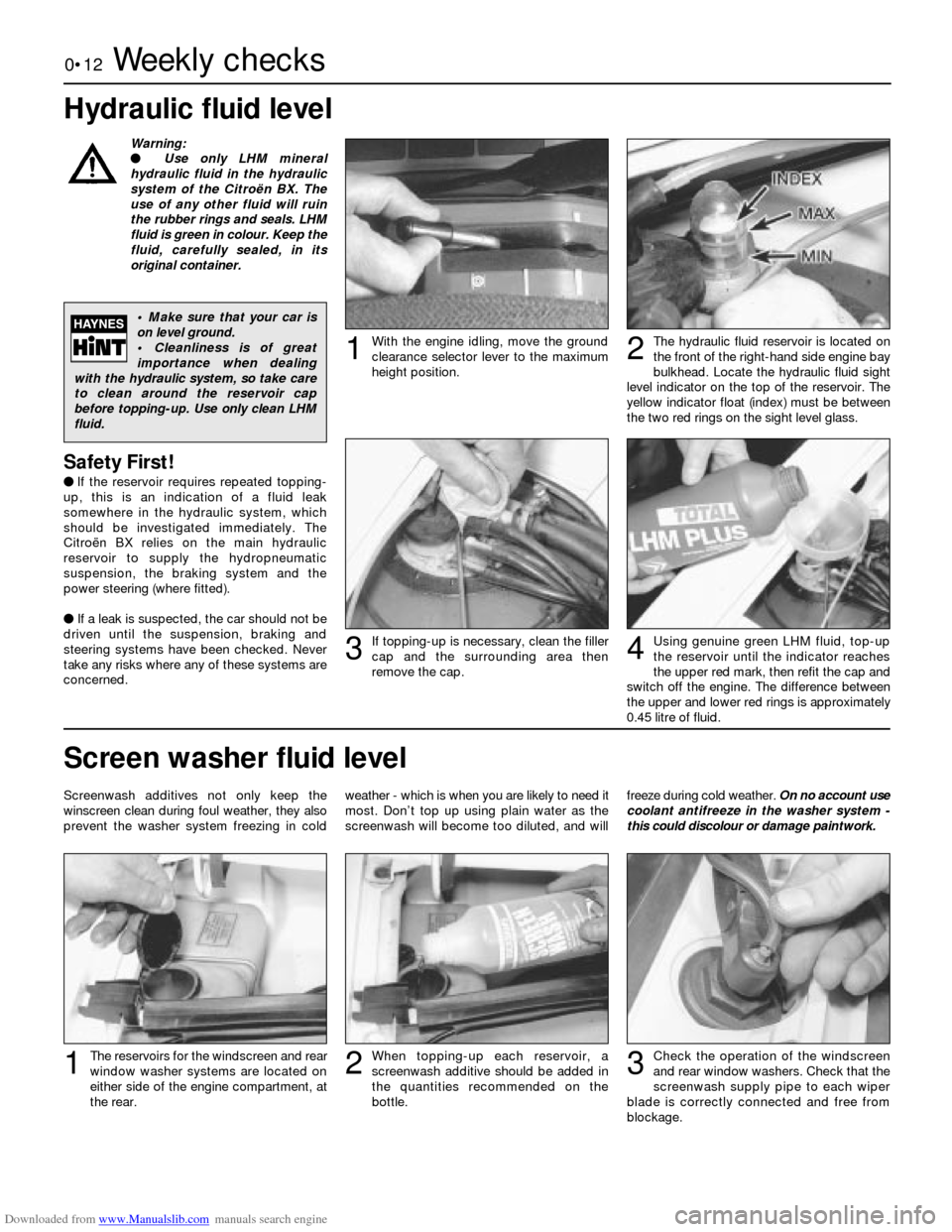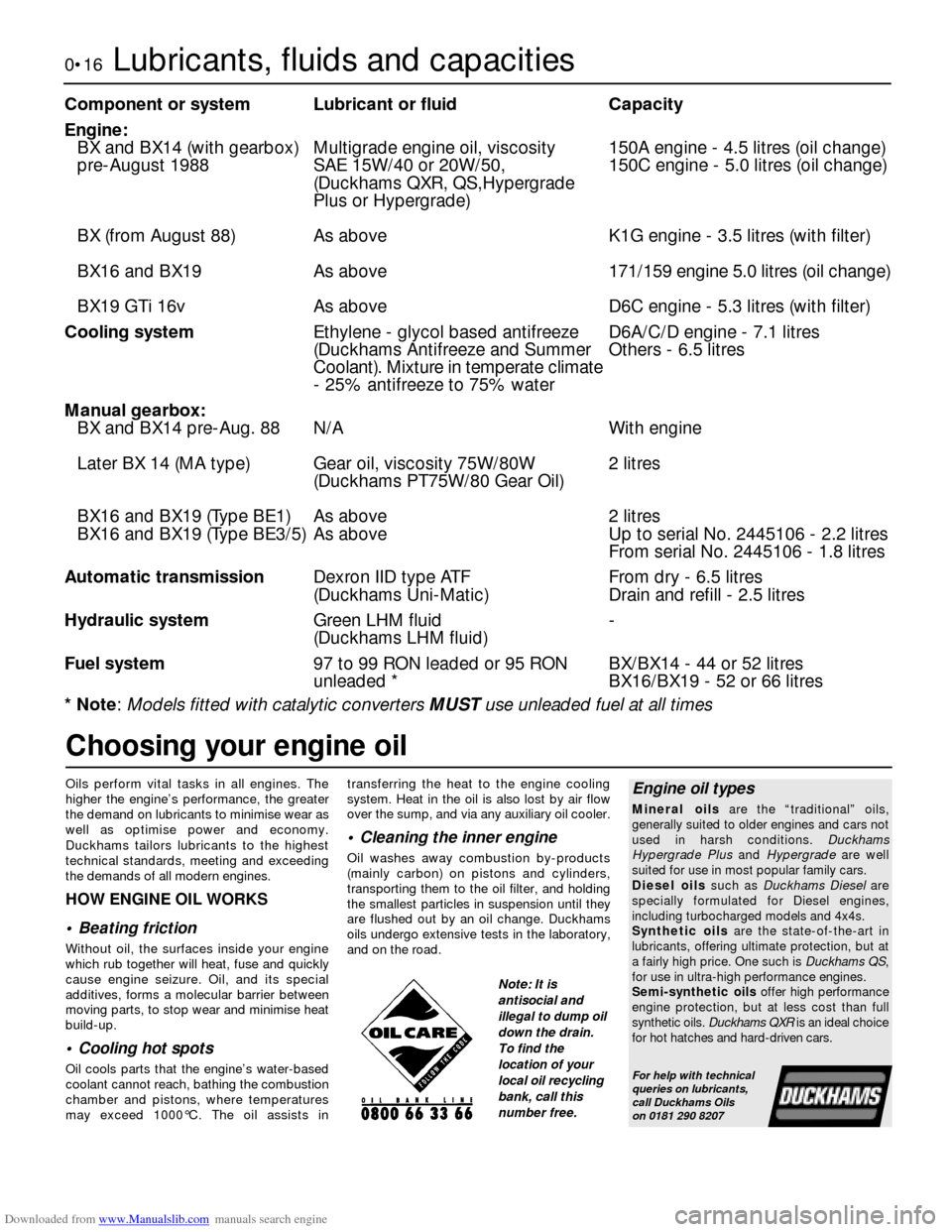engine coolant Citroen BX HATCHBACK 1992 2.G Workshop Manual
[x] Cancel search | Manufacturer: CITROEN, Model Year: 1992, Model line: BX HATCHBACK, Model: Citroen BX HATCHBACK 1992 2.GPages: 16, PDF Size: 0.47 MB
Page 2 of 16

Downloaded from www.Manualslib.com manuals search engine LIVING WITH YOUR CITROEN BX
IntroductionPage0•4
Safety First!Page0•5
Roadside Repairs
Introduction Page0•6
If your car won’t startPage0•6
Jump startingPage0•7
Wheel changingPage0•8
Identifying leaksPage0•9
TowingPage0•9
Weekly Checks
IntroductionPage0•10
Underbonnet check points Page0•10
Engine oil levelPage0•11
Coolant levelPage0•11
Hydraulic fluid levelPage0•12
Screen washer fluid level Page0•12
Tyre condition and pressure Page0•13
Electrical systemsPage0•14
BatteryPage0•14
Wiper bladesPage0•15
Tyre pressuresPage0•15
Lubricants, fluids and capacitiesPage0•16
MAINTENANCE
Routine Maintenance and Servicing
Servicing Specifications Page1•2
Maintenance schedule Page1•4
Maintenance procedures Page1•8
Contents
Page 10 of 16

Downloaded from www.Manualslib.com manuals search engine 0•10Weekly checks
There are some very simple checks which
need only take a few minutes to carry out, but
which could save you a lot of inconvenience
and expense.
These "Weekly checks" require no great skill
or special tools, and the small amount of time
they take to perform could prove to be very
well spent, for example;MKeeping an eye on tyre condition and
pressures, will not only help to stop them
wearing out prematurely, but could also save
your life.
M
Many breakdowns are caused by electrical
problems. Battery-related faults are particularly
common, and a quick check on a regular basis
will often prevent the majority of
these.MIf your car develops a brake fluid leak, the
first time you might know about it is when
your brakes don't work properly. Checking
the level regularly will give advance warning of
this kind of problem.
MIf the oil or coolant levels run low, the cost
of repairing any engine damage will be far
greater than fixing the leak, for example.
Introduction
§BX 16 RE
All other models similar
AEngine oil level dipstick (may
be at front or rear of engine)
BEngine oil filler cap
CCoolant filler cap
DHydraulic fluid reservoir
EScreen washer fluid reservoir
FBattery
Underbonnet check points
Page 11 of 16

Downloaded from www.Manualslib.com manuals search engine Weekly checks0•11
Engine oil level
Before you start
4Make sure that your car is on level ground.
4Check the oil level before the car is driven,
or at least 5 minutes after the engine has been
switched off.
The correct oilModern engines place great demands on their
oil. It is very important that the correct oil for
your car is used (See “Lubricants, fluids and
capacities”).
Car Care
l If you have to add oil frequently, you should
check whether you have any oil leaks. Place
some clean paper under the car overnight,
and check for stains in the morning. If there
are no leaks, the engine may be burning oil
(see “Fault Finding”).
lAlways maintain the level between the
upper and lower dipstick marks (see photo 3).
If the level is too low severe engine damage
may occur. Oil seal failure may result if the
engine is overfilled by adding too much oil.
If the oil is checked
immediately after driving the
vehicle, some of the oil will
remain in the upper engine
components, resulting in an inaccurate
reading on the dipstick!
Depending on engine type, the dipstick is
located either at the back or the front of
the engine (see “Underbonnet Check
Points” on pages 0•10 for exact location).
Withdraw the dipstick.Using a clean rag or paper towel remove
all oil from the dipstick. Insert the clean
dipstick into the tube as far as it will go,
then withdraw it again.
Note the oil level on the end of the
dipstick, which should be between the
upper ("MAX") mark and lower ("MIN")
mark. Approximately 1.0 litre of oil will raise
the level from the lower mark to the upper
mark.Oil is added through the filler cap.
Unscrew the cap and top-up the level; a
funnel may help to reduce spillage. Add
the oil slowly, checking the level on the dipstick
often. Don’t overfill (see “Car Care” left).
12
34
Warning: DO NOT attempt to
remove the expansion tank
pressure cap when the engine
is hot, as there is a very great
risk of scalding. Do not leave
open containers of coolant
about, as it is poisonous.Car Care
lWith a sealed-type cooling system, adding
coolant should not be necessary on a regular
basis. If frequent topping-up is required, it is
likely there is a leak. Check the radiator, all
hoses and joint faces for signs of staining or
wetness, and rectify as necessary.lIt is important that antifreeze is used in the
cooling system all year round, not just during
the winter months. Don’t top-up with water
alone, as the antifreeze will become too
diluted.
Coolant level
The coolant level varies with engine
temperature. To check the level, wait until
the engine is cold then unscrew the filler
cap until a hissing sound is heard. When the
hissing ceases, indicating that all pressure is
released, slowly unscrew and remove the cap.
If more hissing is heard, wait until it stops
before unscrewing the cap completely. At all
times keep well away from the filler opening.On early BX models, the coolant depth,
when cold, must be 250 to 300 mm from
the top of the filler neck. The engine oil
dipstick can be used to check the level but
wipe it off before and after use. Later models
have a tubular dipstick in the filler neck, the
coolant must be between the MIN and MAX
marks on the dipstick.If necessary, add the recommended
mixture of water and antifreeze through
the filler orifice, until the coolant is up to
the maximum level. Refit the cap, ensuring it
is secure.123
Page 12 of 16

Downloaded from www.Manualslib.com manuals search engine 0•12Weekly checks
Hydraulic fluid level
Warning:
l Use only LHM mineral
hydraulic fluid in the hydraulic
system of the Citroën BX. The
use of any other fluid will ruin
the rubber rings and seals. LHM
fluid is green in colour. Keep the
fluid, carefully sealed, in its
original container.
Safety First!
lIf the reservoir requires repeated topping-
up, this is an indication of a fluid leak
somewhere in the hydraulic system, which
should be investigated immediately. The
Citroën BX relies on the main hydraulic
reservoir to supply the hydropneumatic
suspension, the braking system and the
power steering (where fitted).
lIf a leak is suspected, the car should not be
driven until the suspension, braking and
steering systems have been checked. Never
take any risks where any of these systems are
concerned.
• Make sure that your car is
on level ground.
• Cleanliness is of great
importance when dealing
with the hydraulic system, so take care
to clean around the reservoir cap
before topping-up. Use only clean LHM
fluid.
With the engine idling, move the ground
clearance selector lever to the maximum
height position.1The hydraulic fluid reservoir is located on
the front of the right-hand side engine bay
bulkhead. Locate the hydraulic fluid sight
level indicator on the top of the reservoir. The
yellow indicator float (index) must be between
the two red rings on the sight level glass.2
If topping-up is necessary, clean the filler
cap and the surrounding area then
remove the cap.3Using genuine green LHM fluid, top-up
the reservoir until the indicator reaches
the upper red mark, then refit the cap and
switch off the engine. The difference between
the upper and lower red rings is approximately
0.45 litre of fluid.4
Screenwash additives not only keep the
winscreen clean during foul weather, they also
prevent the washer system freezing in coldweather - which is when you are likely to need it
most. Don’t top up using plain water as the
screenwash will become too diluted, and willfreeze during cold weather. On no account use
coolant antifreeze in the washer system -
this could discolour or damage paintwork.
Screen washer fluid level
When topping-up each reservoir, a
screenwash additive should be added in
the quantities recommended on the
bottle.2The reservoirs for the windscreen and rear
window washer systems are located on
either side of the engine compartment, at
the rear.1Check the operation of the windscreen
and rear window washers. Check that the
screenwash supply pipe to each wiper
blade is correctly connected and free from
blockage.3
Page 16 of 16

Downloaded from www.Manualslib.com manuals search engine 0•16Lubricants, fluids and capacities
Component or system Lubricant or fluid Capacity
Engine:
BX and BX14 (with gearbox) Multigrade engine oil, viscosity 150A engine - 4.5 litres (oil change)
pre-August 1988 SAE 15W/40 or 20W/50, 150C engine - 5.0 litres (oil change)
(Duckhams QXR, QS,Hypergrade
Plus or Hypergrade)
BX (from August 88) As above K1G engine - 3.5 litres (with filter)
BX16 and BX19 As above171/159 engine 5.0 litres (oil change)
BX19 GTi 16v As above D6C engine - 5.3 litres (with filter)
Cooling systemEthylene - glycol based antifreeze D6A/C/D engine - 7.1 litres
(Duckhams Antifreeze and Summer Others - 6.5 litres
Coolant). Mixture in temperate climate
- 25% antifreeze to 75% water
Manual gearbox:
BX and BX14 pre-Aug. 88 N/A With engine
Later BX 14 (MA type) Gear oil, viscosity 75W/80W 2 litres
(Duckhams PT75W/80 Gear Oil)
BX16 and BX19 (Type BE1) As above 2 litres
BX16 and BX19 (Type BE3/5) As above Up to serial No. 2445106 - 2.2 litres
From serial No. 2445106 - 1.8 litres
Automatic transmissionDexron IID type ATF From dry - 6.5 litres
(Duckhams Uni-Matic) Drain and refill - 2.5 litres
Hydraulic systemGreen LHM fluid -
(Duckhams LHM fluid)
Fuel system97 to 99 RON leaded or 95 RON BX/BX14 - 44 or 52 litres
unleaded * BX16/BX19 - 52 or 66 litres
* Note: Models fitted with catalytic converters MUSTuse unleaded fuel at all times
Oils perform vital tasks in all engines. The
higher the engine’s performance, the greater
the demand on lubricants to minimise wear as
well as optimise power and economy.
Duckhams tailors lubricants to the highest
technical standards, meeting and exceeding
the demands of all modern engines.
HOW ENGINE OIL WORKS
• Beating friction
Without oil, the surfaces inside your engine
which rub together will heat, fuse and quickly
cause engine seizure. Oil, and its special
additives, forms a molecular barrier between
moving parts, to stop wear and minimise heat
build-up.
• Cooling hot spots
Oil cools parts that the engine’s water-based
coolant cannot reach, bathing the combustion
chamber and pistons, where temperatures
may exceed 1000°C. The oil assists intransferring the heat to the engine cooling
system. Heat in the oil is also lost by air flow
over the sump, and via any auxiliary oil cooler.
• Cleaning the inner engine
Oil washes away combustion by-products
(mainly carbon) on pistons and cylinders,
transporting them to the oil filter, and holding
the smallest particles in suspension until they
are flushed out by an oil change. Duckhams
oils undergo extensive tests in the laboratory,
and on the road.
Engine oil types
Mineral oilsare the “traditional” oils,
generally suited to older engines and cars not
used in harsh conditions. Duckhams
Hypergrade Plus and Hypergradeare well
suited for use in most popular family cars.
Diesel oilssuch as Duckhams Dieselare
specially formulated for Diesel engines,
including turbocharged models and 4x4s.
Synthetic oilsare the state-of-the-art in
lubricants, offering ultimate protection, but at
a fairly high price. One such is Duckhams QS,
for use in ultra-high performance engines.
Semi-synthetic oilsoffer high performance
engine protection, but at less cost than full
synthetic oils. Duckhams QXRis an ideal choice
for hot hatches and hard-driven cars.
For help with technical
queries on lubricants,
call Duckhams Oils
on 0181 290 8207
Choosing your engine oil
Note: It is
antisocial and
illegal to dump oil
down the drain.
To find the
location of your
local oil recycling
bank, call this
number free.